
The foreign relations of the People's Republic of China (PRC), commonly known to most states as China, has full diplomatic relations with 178 out of the other 193 United Nations member states, Cook Islands, Niue and the State of Palestine. Since 2019, China has had the most diplomatic missions of any country in the world. This article guides the way in which China interacts with foreign nations and expresses its political and economic weaknesses and values. As a great power and an emerging superpower, China's foreign policy and strategic thinking are highly influential. China officially claims it "unswervingly pursues an independent foreign policy of peace". The fundamental goals of this policy are to preserve China's independence, sovereignty and territorial integrity, create a favorable international environment for China's reform and opening up and modernization of construction, and to maintain world peace and propel common development." An example of a foreign policy decision guided by "sovereignty and territorial integrity" is not engaging in diplomatic relations with any country that recognizes the Republic of China (Taiwan), which the PRC does not recognise as a separate nation.

The People's Liberation Army Navy, also known as the Chinese Navy or PLA Navy, is the naval warfare branch of the People's Liberation Army, the armed wing of the Chinese Communist Party (CCP) and, by default, the national armed forces of the People's Republic of China (PRC). The PLAN traces its lineage to naval units fighting during the Chinese Civil War and was established on 23 April 1949. Throughout the 1950s and early 1960s, the Soviet Union provided assistance to the PLAN in the form of naval advisers and export of equipment and technology.

The East China Sea is an arm of the Western Pacific Ocean, located directly offshore from East China, covering an area of roughly 1,249,000 square kilometers (482,000 sq mi). Its northern extension between mainland China and the Korean Peninsula is the Yellow Sea, separated by an imaginary line between the eastern tip of Qidong at the Yangtze River estuary and the southwestern tip of South Korea's Jeju Island.
The Blue Team is an informal term for a group of politicians and journalists in United States loosely unified by their belief that the People's Republic of China is a significant security threat to the United States. Though allied on some issues with Democratic advocates of labor, most of those to whom the term has been applied are conservative or neoconservative. However, few occupied positions of high power within the Bush administration, instead tending to work for the Pentagon, the US Intelligence Community, private think tanks, and media outlets.
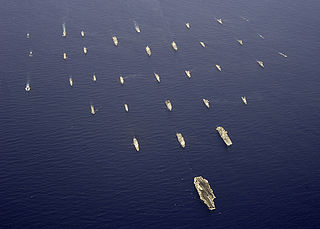
A blue-water navy is a maritime force capable of operating globally, essentially across the deep waters of open oceans. While definitions of what actually constitutes such a force vary, there is a requirement for the ability to exercise sea control at long range.
The United States foreign policy toward the People's Republic of China originated during the Cold War. At that time, the U.S. had a containment policy against communist states. The leaked Pentagon Papers indicated the efforts by the U.S. to contain China through military actions undertaken in the Vietnam War. The containment policy at East Asia island arcs is called "the First and Second island chains". President Richard Nixon's China rapprochement signaled a shift in focus to gain leverage in containing the Soviet Union. Formal diplomatic ties between the U.S. and China were established in 1979, and with normalized trade relations since 2000, the U.S. and China have been linked by closer economic ties and more cordial relations.

Nanshin-ron was a political doctrine in the Empire of Japan that stated that Southeast Asia and the Pacific Islands were Japan's sphere of interest and that their potential value to the Empire for economic and territorial expansion was greater than elsewhere.

India's Look East policy is an effort to cultivate extensive economic and strategic relations with the nations of Southeast Asia to bolster its standing as a regional power and a counterweight to the strategic influence of the People's Republic of China. Initiated in 1991, it marked a strategic shift in India’s perspective of the world. It was developed and enacted during the government of Prime Minister Narsimha Rao (1991–1996) and rigorously pursued by the successive administrations of Atal Bihari Vajpayee (1998–2004) and Manmohan Singh (2004–2014).
The String of Pearls is a geopolitical hypothesis proposed by United States political researchers in 2004. The term refers to the network of Chinese military and commercial facilities and relationships along its sea lines of communication, which extend from the Chinese mainland to Port Sudan in the Horn of Africa. The sea lines run through several major maritime choke points such as the Strait of Mandeb, the Strait of Malacca, the Strait of Hormuz, and the Lombok Strait as well as other strategic maritime centres in Pakistan, Sri Lanka, Bangladesh, the Maldives, and Somalia.

The territorial conquests of the Empire of Japan in the Western Pacific and East Asia regions began in 1895 with its victory over Qing China in the First Sino-Japanese War. Subsequent victories over the Russian and German Empires expanded Japanese rule to Taiwan, Korea, Micronesia, and southern Sakhalin. In 1931, Japan invaded Manchuria, resulting in the establishment of the puppet state of Manchukuo the following year; thereafter, Japan adopted a policy of founding and supporting puppet states in conquered regions. These conquered territories became the basis for the Greater East Asia Co-Prosperity Sphere in 1940.
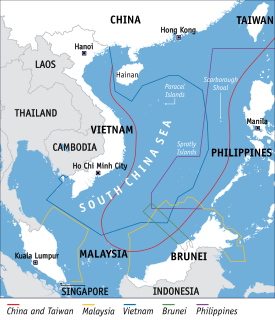
The South China Sea disputes involve both island and maritime claims within the region by several sovereign states, namely Brunei, the People's Republic of China (PRC), Taiwan, Indonesia, Malaysia, the Philippines, and Vietnam. An estimated US$3.37 trillion worth of global trade passes through the South China Sea annually, which accounts for a third of the global maritime trade. 80 percent of China's energy imports and 39.5 percent of China's total trade passes through the South China Sea.
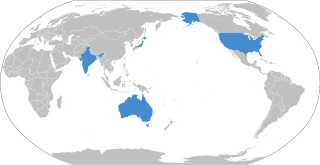
The Quadrilateral Security Dialogue (QSD), colloquially the Quad or QUAD, is a strategic security dialogue between Australia, India, Japan, and United States that is maintained by talks between member countries. The dialogue was initiated in 2007 by Japanese Prime Minister Shinzo Abe, with the support of Australian Prime Minister John Howard, Indian Prime Minister Manmohan Singh, and U.S. Vice President Dick Cheney. The dialogue was paralleled by joint military exercises of an unprecedented scale, titled Exercise Malabar. The diplomatic and military arrangement was widely viewed as a response to increased Chinese economic and military power, and the Chinese government responded to the Quadrilateral dialogue by issuing formal diplomatic protests to its members, calling it "Asian NATO".
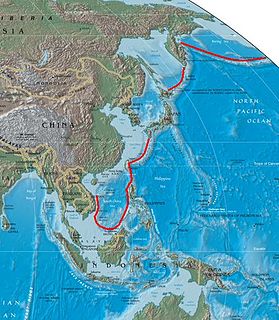
The first island chain refers to the first chain of major archipelagos out from the East Asian continental mainland coast. It is principally composed of the Kuril Islands, the Japanese Archipelago, the Ryukyu Islands, Taiwan (Formosa), the northern Philippines, and Borneo, hence extending all the way from the Kamchatka Peninsula in the northeast to the Malay Peninsula in the southwest. Some definitions of the first island chain anchor the northern end on the Russian Far East coast north of Sakhalin Island, with Sakhalin Island being the first link in the chain. However, others consider the Aleutians as the farthest north-eastern first link in the chain. The first island chain forms one of three island chain doctrines within the Island Chain Strategy in US foreign policy.
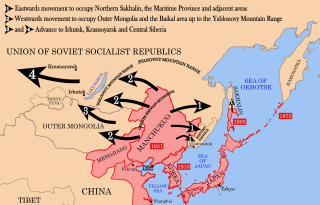
Hokushin-ron was a pre-World War II political doctrine of the Empire of Japan which stated that Manchuria and Siberia were Japan's sphere of interest and that the potential value to Japan for economic and territorial expansion in those areas was greater than elsewhere. Its supporters were sometimes called the Strike North Group. It enjoyed wide support within the Imperial Japanese Army during the interwar period, but was abandoned in 1939 after military defeat on the Mongolian front at the Battles of Khalkhin Gol and the signing of Soviet–Japanese Neutrality Pact in 1941. It was superseded by the diametrically-opposite rival policy, Nanshin-ron, which regarded Southeast Asia and the Pacific Islands as Japan's political and economic sphere of influence and aimed to acquire the resources of European colonies while neutralising the threat of Western military forces in the Pacific.
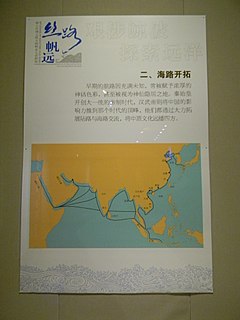
The Maritime Silk Road or Maritime Silk Route is the maritime section of the historic Silk Road that connected Southeast Asia, China, the Indian subcontinent, the Arabian peninsula, Somalia, Egypt and Europe. It began by the 2nd century BCE and flourished later on until the 15th century CE. The Maritime Silk Road was primarily established and operated by Austronesian sailors in Southeast Asia, Tamil merchants in India and Southeast Asia, and by Persian and Arab traders in the Arabian Sea and beyond. The network followed the footsteps of an older maritime network, the Maritime Jade Road of Taiwan and maritime Southeast Asia, as well as the maritime spice networks of Southeast Asia, Sri Lanka, India, and the Indian Ocean, coinciding with these ancient maritime trade roads by the current era.
The People's Republic of China is a Communist state that came to power in 1949 after a civil war. It became a great power in the 1960s and today has the world's largest population, second largest GDP (nominal) and the largest economy in the world by PPP. China is now considered an emerging global superpower. The main institutions of foreign policy are the Ministry of Foreign Affairs, the International Liaison Department of the Chinese Communist Party, and the United Front Work Department.
Underwater domain awareness (UDA) is the aspect of maritime domain awareness focused on the underwater sector, including, from a security perspective, sea lines of communication (SLOC), coastal waters and varied maritime assets with reference to hostile intent and the proliferation of submarine and mine capabilities intended to limit access to the seas and littoral waters. The military requirement is not the only motivation for undersea domain awareness. The earth’s undersea geophysical activities as they relate to the well-being of humans is also relevant, as monitoring such activities can provide vital clues to minimize the impact of devastating natural disasters.
Geostrategy in Taiwan refers to the foreign relations of Taiwan in the context of the geography of Taiwan. Taiwan is an island country in East Asia, while it is also located at the center of the first island chain and commands the busy traffic of Taiwan Strait and Bashi Channel.
SAGAR, used as a backronym or reverse acronym which stands for Security and Growth for All in the Region, is a label used by the Prime Minister and Government of India for India's vision and geopolitical framework of maritime cooperation in the Indian Ocean region. Sagar is the Hindi word for 'ocean' or 'sea'. Since the first usage of the phrase in 2015 at Port Louis by Prime Minister Narendra Modi the term has been adapted to include more elements such as linkages with the Indo-Pacific region.

Free and Open Indo-Pacific is an umbrella term that encompasses Indo-Pacific-specific strategies of countries with similar interests in the region. The concept has been developed through Japanese and American cooperation.













